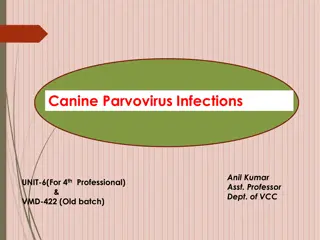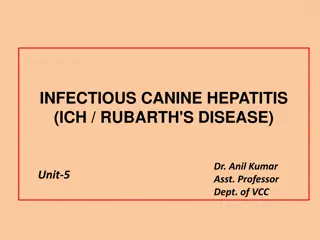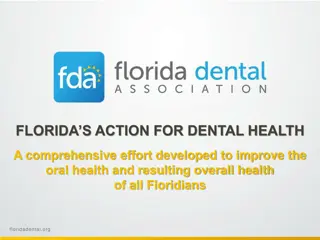Canine and Feline Dental Classification and Grading Scale
Learn about the dental classification and grading scale for dogs and cats, ranging from Grade 0 (no plaque or gingivitis) to Grade 4 (overt peri-dontal disease). Each grade describes the level of tartar, gingivitis, infections, pain, and necessary actions for treatment. It provides insights into the importance of dental care and maintenance for the oral health of young and adult pets.
Download Presentation

Please find below an Image/Link to download the presentation.
The content on the website is provided AS IS for your information and personal use only. It may not be sold, licensed, or shared on other websites without obtaining consent from the author.If you encounter any issues during the download, it is possible that the publisher has removed the file from their server.
You are allowed to download the files provided on this website for personal or commercial use, subject to the condition that they are used lawfully. All files are the property of their respective owners.
The content on the website is provided AS IS for your information and personal use only. It may not be sold, licensed, or shared on other websites without obtaining consent from the author.
E N D
Presentation Transcript
Grade 0 No plaque or gingivitis. Young healthy dogs and cats 6-12 months.
Grade 1 Plaque formation on some teeth mainly premolars and molars. Mild gingivitis along gum line. No evidence of infection.
Grade 2 Evidence of mild to moderate tartar (mineralised plaque) affecting most teeth. Moderate gingivitis. No evidence of infection.
Grade 3 Significant tartar. Gingivitis and oedema of the gum margin. Infection. Halitosis. Some oral pain. At least 2 teeth require extraction. Some loose or fractured teeth. 2 or more teeth with obvious neck lesions (FORLs).
Grade 4 Overt peri-dontal disease (gum recession, tooth roots visible). Marked pain and halitosis. Inappetence. Multiple loose teeth. Multiple extractions required. Reluctance to open mouth.
Grade Description Action Grading scale No plaque or gingivitis. Young healthy dogs 6-12 months 0 Nothing Plaque formation on some teeth mainly premolars and molars. Mild gingivitis along gum line. No evidence of infection. 1 Dogs- may be reversed by brushing, dental chews, plaque off. Cats suggest dental diet. Evidence of mild to mod tartar (mineralised plaque) affecting most teeth. Moderate gingivitis. No evidence of infection 2 As above, re assess all cases within 6 months. Consider scale and polish in patients where cleaning not practical Significant tartar. Gingivitis and oedema of gum margin. Infection. Halitosis. Some oral pain. At least 2 teeth may need extraction. Some loose or fractured teeth. 2 or more teeth with obvious neck lesions. (FORLS). 3 Dental extractions required with antibiotics. Overt peri-dontal disease (gum recession, tooth roots visible.) Marked pain and halitosis. Inapetence. Multiple loose teeth. Multiple extractions required. Reluctance to open mouth. 4 Dental extractions required urgently with antibiotics (+/- IVFT)























